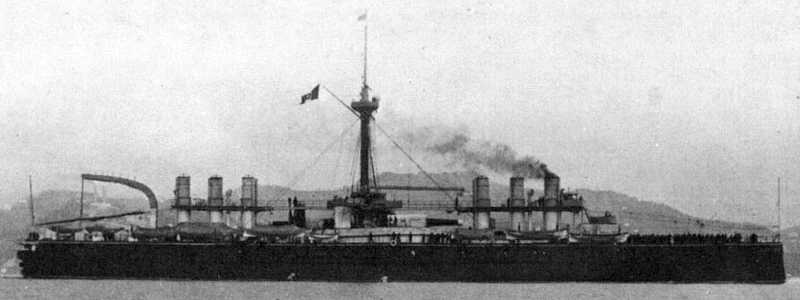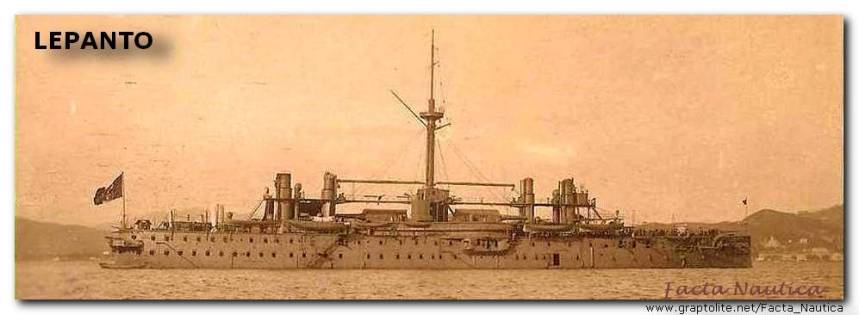Warship Wednesday August 20: The Impressive Italian 17-inch Heroes
Here at LSOZI, we are going to take out every Wednesday for a look at the old steam/diesel navies of the 1859-1946 time period and will profile a different ship each week.
– Christopher Eger
Warship Wednesday August 20 The Impressive Italian 17-inch Heroes

Here we see the giant and remarkable for the time Italia-class battlewagon Lepanto. Designed by the famous Benedetto Brin in the 1870s to bring peace and tranquility to the Med– under the Italian tri-color– the two-ship Italia-class was the pride and joy of the Regia Marina.
Tipping the scales at over 15,000-tons, these 409-foot steel-hulled brawlers could make an impressive 18.4-knots on their 15,797 shp plant. What is truly remarkable about these ships is that they had a brace of four 17-inch (432mm) naval guns. That’s not a misprint– we are talking about 17-inch rifled cannon in 1876. Of course they were black powder and only some 26-calibers long, but you have to admit that is impressive.
Due to their length and weight, these guns were set up en echelon amidships in a single, large, diagonal, oval barbette, with one pair of guns on a turntable to port and the other to starboard.
Italia was laid down in 1876 at Castellammare Naval Shipyard while Lepanto began construction at Orlando in Livorno at the same time. However, these ships were so new for the time, I mean think about it, the U.S. Civil War had just ended a decade before, that they languished on the builders ways until after 1885, nearly a decade later when they were commissioned.
These were huge, deep ships for the time. Besides the massive main armament and a dozen secondary 6-inch and 4.7-inch guns, each could carry a full 10,000-man infantry division in a pinch. Now that is power projection.
These gentle giants, with their distinctive six-funnel profile (Lepanto always just had four though), cruised the Med for a generation but saw little active use. By 1902 Lepanto was placed in reduced service as a gunnery training ship and then a non-functional depot vessel within the decade.
Sistership Italia lasted a bit longer, earning a refit in 1905 then serving as a torpedo training ship and floating harbor defense craft in World War One. While Lepanto was sold for scrapping on 27 March 1915, Italia suffered an even worse fate. Disarmed after the war, she was used to carry grain to Italian troops in North Africa until being finally stricken 16 November 1921 and subsequently scrapped.
No known memorial exists to these interesting 17-inch Roman battlewagons.
Specs:
Displacement: 13,336 long tons (13,550 t) normal
15,649 long tons (15,900 t) full load
Length: 400 ft 3 in (122.0 m) between perpendiculars
409 ft 1 in (124.7 m) length overall
Beam: 73 ft 4 in (22.4 m)
Draft: 30 ft 9 in (9.4 m)
Installed power: 15,797 ihp (11,780 kW)
Propulsion: 4 shafts, vertical compound engines, 8 oval and 16 cylindrical boilers
Speed: 18.4 knots (21.2 mph; 34.1 km/h)
Range: ca. 5,000 nautical miles (9,260 km) at 10 knots (19 km/h; 12 mph)
Troops: Up to 10,000
Complement: 669, later 701
Armament: As built:
*4 × 17-inch (432 mm)/26 guns
*8 × 6-inch (152 mm)/32 guns
*4 × 4.7-inch (119 mm)/32 guns
*4 × 14-inch (356 mm) torpedo tubes
Added later:
*2 × 75mm guns
*12 × 57mm quick-firing guns
*12 × 37mm revolvers
*2 × machine guns
From 1902:
*4 × 17-inch (432 mm)/26 guns
*4 × 4.7-inch (119 mm)/32 guns
9 × 57mm guns
6 × 37mm/25 revolvers
2 × machine guns
Torpedo tubes removed after 1902
Armor: Steel armor
Belt and side: None
Deck: 4 in (101.6 mm)
Citadel: 19 in (483 mm)
Funnel base: 16 in (406 mm)
Conning tower: 4 in (102 mm)
If you liked this column, please consider joining the International Naval Research Organization (INRO)
They are possibly one of the best sources of naval lore http://www.warship.org/naval.htm
The International Naval Research Organization is a non-profit corporation dedicated to the encouragement of the study of naval vessels and their histories, principally in the era of iron and steel warships (about 1860 to date). Its purpose is to provide information and a means of contact for those interested in warships.
Nearing their 50th Anniversary, Warship International, the written tome of the INRO has published hundreds of articles, most of which are unique in their sweep and subject.
I’m a member, so should you be!






Pingback: Italia class Ironclads